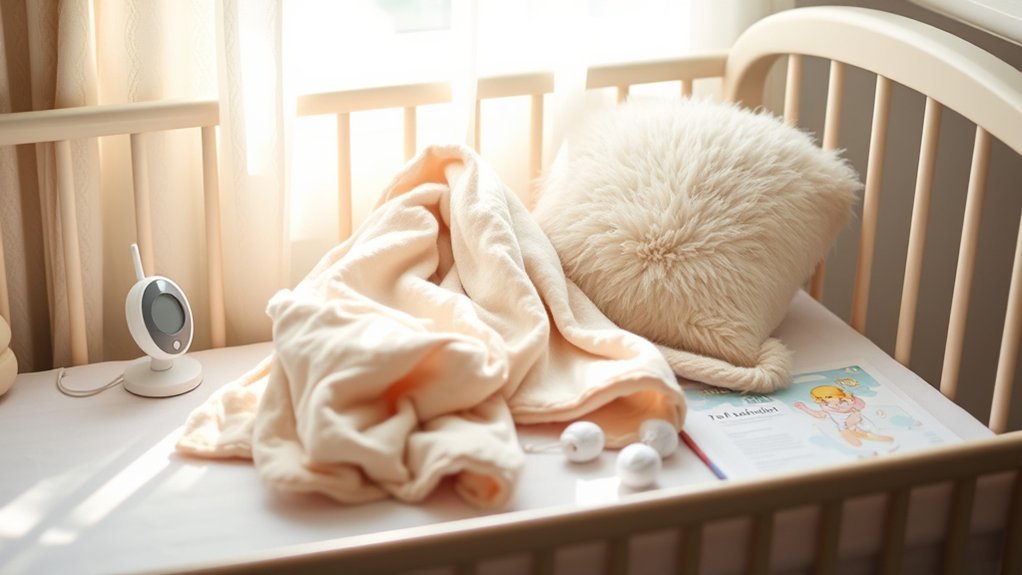When it comes to blanket and pillow safety, it’s crucial to recognize the signs that could indicate a problem. You might notice symptoms like difficulty breathing or unusual allergic reactions, which can stem from unsuitable bedding materials. Inspecting for wear and tear is just as important. Understanding these risks can make all the difference in creating a safe sleeping environment for you and your loved ones. But what specific signs should you be looking for?
Understanding Suffocation Risks in Bedding
When you choose bedding for yourself or your loved ones, it’s crucial to understand the suffocation risks involved.
Soft bedding materials, such as plush blankets and oversized pillows, can pose a danger, especially for infants and young children. Their small size and developing motor skills increase vulnerability to suffocation.
Opt for firm, fitted bedding that keeps the sleeping area clear of excess fabric or bulky items. Avoid loose blankets and large pillows, as these can obstruct breathing.
Always position infants on their backs and guarantee their sleep environment is safe, using sleep sacks instead of blankets.
Recognizing Allergic Reactions to Materials
Recognizing allergic reactions to bedding materials is essential for ensuring a safe and comfortable sleep environment. If you notice symptoms like sneezing, itching, or rashes after sleeping, it might indicate an allergy.
Pay attention to more severe reactions, such as difficulty breathing or swelling, which require immediate medical attention. Common culprits include synthetic fabrics, feather fillings, and certain dyes or chemicals.
When choosing bedding, opt for hypoallergenic materials and wash them regularly to minimize allergens. Be vigilant about dust mites, mold, and pet dander, as they can also trigger allergies.
Identifying Inappropriate Pillow Height and Firmness
How can you tell if your pillow’s height and firmness are causing discomfort?
First, pay attention to your neck and spine alignment while you sleep. If your neck bends unnaturally or you wake up with pain, your pillow might be too high or too low. A proper pillow should keep your head aligned with your spine.
Pay attention to your neck alignment; a proper pillow should keep your head aligned with your spine to prevent discomfort.
Next, evaluate the firmness. If the pillow feels too hard or too soft, it may not support your head adequately. You should be able to rest comfortably without sinking too deeply or feeling unsupported.
Finally, consider your sleeping position. Side sleepers generally need firmer, higher pillows, while stomach sleepers benefit from softer, flatter options.
Adjusting your pillow can lead to better sleep quality.
Spotting Signs of Wear and Tear on Blankets and Pillows
Your sleep environment plays a significant role in overall comfort, and blankets and pillows can wear out over time.
To guarantee your rest remains restorative, keep an eye out for signs of wear and tear. Check for frayed edges, visible stains, or holes in your blankets that compromise their integrity.
For pillows, look for lumps or a significant loss of shape; if they no longer provide support, it’s time to replace them. Pay attention to odors, too, as lingering smells can indicate bacteria buildup.
Regularly evaluating these items helps you maintain a healthy sleep space, guaranteeing your comfort and well-being.
Assessing Temperature Regulation and Breathability
While many factors contribute to a comfortable sleep environment, evaluating the temperature regulation and breathability of your blankets and pillows is essential.
Materials like cotton, bamboo, and certain synthetics offer excellent breathability, allowing air circulation that helps maintain an even temperature. If you feel overheated or clammy during the night, your bedding may be trapping heat.
Breathable materials like cotton and bamboo enhance air circulation, preventing overheating and ensuring a comfortable night’s sleep.
Consider investing in moisture-wicking fabrics, especially if you’re prone to night sweats.
Additionally, look for pillows with adjustable fill; these can help you achieve the desired loft and airflow.
Regularly check for any signs of excessive wear, as this can compromise both temperature regulation and breathability.
Prioritizing these aspects can greatly enhance your sleep quality and overall comfort.
Frequently Asked Questions
How Often Should I Replace My Pillows and Blankets?
You should replace your pillows every 1 to 2 years and blankets every 3 to 5 years. Regularly check for signs of wear and allergens to guarantee your comfort and health remain a priority.
Can Pets Cause Safety Issues With Bedding?
Imagine a gentle storm brewing in your cozy nest. Pets can definitely stir up safety issues with bedding—think allergens, bites, or entanglement. Keep an eye on their habits to guarantee your sanctuary remains safe.
What Should I Do if My Child Refuses to Sleep With a Blanket?
If your child refuses to sleep with a blanket, try discussing their feelings. Offer alternatives like a lighter cover or a favorite stuffed animal. Make certain they feel secure and comfortable, fostering a peaceful sleep environment.
Are There Specific Materials Safer for Infants?
Think of a gentle cloud cradling your infant. Opt for breathable, hypoallergenic materials like cotton or bamboo. They’re soft and reduce allergy risks, ensuring your baby’s comfort and safety during those precious sleep moments.
How Can I Properly Clean My Pillows and Blankets?
To properly clean your pillows and blankets, wash them in warm water with gentle detergent. Use a gentle cycle, and dry them on low heat. Always check care labels for specific cleaning instructions to guarantee longevity.
Conclusion
In the pursuit of safe slumber, being vigilant about blanket and pillow safety is key. Just as a guardian watches over a sleeping child, you must regularly assess bedding for suffocation risks, allergens, and signs of wear. By ensuring the right pillow height and maintaining breathability, you can create a sanctuary for restful nights. Remember, a safe sleep environment fosters sweet dreams, allowing your loved ones to drift peacefully into a world where worries fade like morning mist.
